
Image Is Everything
ACMI's new Story of the Moving Image is ready for change even before it opened.
Text:/ Christopher Holder
‘If it ain’t broke, don’t fix it.’ It’s a maxim that could probably be on the coat of arms of museum and exhibition AV people everywhere. Once it’s working, a piece of exhibition AV could be locked off for a decade or more. Don’t connect it to the network, make sure there aren’t any operating system upgrades, maybe Hoover the dust out every so often so nothing overheats and let sleeping ‘technology dogs’ lie. So what if it’s still running XP? If it still works, leave it alone.
ACMI’s previous permanent exhibition, Screen Worlds, opened in 2009, the same year the iPhone launched. When the permanent exhibition closed for total renovation in 2019, that same iPhone3 from 2009 was still on display. In 10 years, screen culture had been totally transformed but exhibition AV technology wasn’t in a position to keep up.
It is now.
MOVING IMAGE, MOVING WITH THE TIMES
The Australian Centre of the Moving Image is now a tent pole tenant of Federation Square in Melbourne. Which is interesting because that was never meant to be the case. The building it occupies was designed for swanky retail.
When Katrina Sedgwick took over the top job at ACMI in 2015 there was a resolve to lobby the state government for funds to make the space more fit for purpose and to reimagine the permanent exhibition space.
The results of the $40m upgrade is impressive. BKK Architecture has addressed virtually every space in the museum, while the technology has been upgraded from the structured cabling onwards — as an aside, all the cat6 cabling is shielded as the building sits of dozens of high-voltage train line pantographs.
The Story of the Moving Image is the new ‘centrepiece’ exhibition. A journey through the past, present and future of film, TV and video games, it’s no longer a ‘permanent’ exhibition, it’s designed to evolve and respond and is packed with interactive experiences.
(above) Story of the Moving Image (Photo: Shannon McGrath)
THE LENS
It’s well known that the best museums invariably have a treasure trove of artefacts squirrelled away in vaults — often never to see the light of day. Modern museums like ACMI may not have drawers of butterflies or mothballed exotic antiquities but is sitting on its own trove of digital treasures.
During the planning phase of the new exhibition the team explored ways of giving visitors the tools to log their favourite bits and to continue their exploration at home with links to related content.
Perhaps 10 years ago, everyone’s hopes were riding on smartphone apps — free wifi and an app ensured everyone would have access to all the info they could possibly desire. These days that space is crowded. To rely on visitors phones means to compete with every other notification and social media platform for visitors’ attention, as well as the drudgery of constantly waking up your phone through the journey.
Instead, the ACMI team developed an NFC disc called The Lens.
Working with Razorfish and then realised by the Swinburne Centre for Design Innovation, The Lens isn’t a download, doesn’t give you a popup every 30 seconds and doesn’t need recharging.
The Lens is a recyclable disc you tap at exhibits to save information and take home to help guide you to more web content you may otherwise have never known existed. In other words, it allows you to take the ACMI exhibition home.
“I think what’s good about The Lens is that it is straightforward — deceptively straight forward.” So says, Seb Chan, ACMI’s chief experience officer. What Seb is getting at is how The Lens ‘knows’ what piece of content you’re particularly interested in when a video wall might be displaying 20 segments. Tap the NFC disc and you want it to save the clip you’re watching, not all 20.
“It was that sort of example that made us think: we’re going to need to build a system that helps us do that. We looked at a bunch of off-the-shelf systems. But the challenge is having a system that allows you to plug directly into your repository of content.”
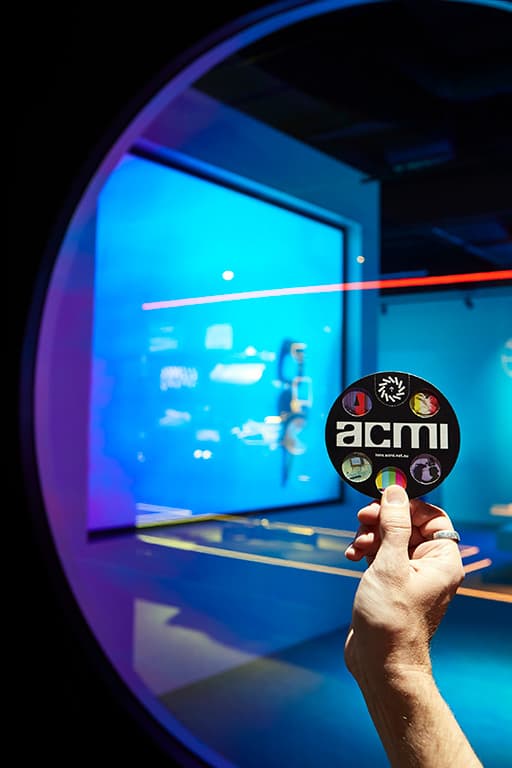
XOS: EMERGING
The answer is XOS or the Experience Operating System. It’s the ‘plumbing’ that makes the job of The Lens possible and it makes a dynamically updatable exhibition possible. It’s a software architecture and suite of Python-based tools that allows the museum’s disparate systems and enterprise databases to communicate with each other. XOS enables the flow of content, data, and controls from back of house to the galleries and out to the web.
Seb Chan: “It connects the playback systems; The Lens interactions of the visitors; and the sources of that content. It enables a curator sitting at their desk to change that music video remotely and have the ability for the visitor to still collect it.”
Seb invokes ‘Monsters Inc’ by way of another way of picturing the purpose of XOS: “It’s like the conveyor belt of doors, making sure those experiences end up in the right places.
“XOS integrates with the other systems, databases and technologies we use in the museum and with the different teams that make the exhibition content, the curators and museum programmers. It also does tasks like transcoding, such that I can get a Pro-Res format video from an artist or a studio and put it onto a 1080p exhibition display with minimum hands touching it.”
NFC: SECRET HERBS
We might rely on NFC to get into hotel rooms or pay for the shopping with our phone but NFC has had a sketchy history when it comes to voluntary ‘more info’ interactions.
Seb Chan: “The success or failure of NFC is down to the final gesture. If it feels a bit janky, then people won’t trust the interaction — ‘did my card read properly?’, is the question you’re always asking. That’s something we spent a lot of time perfecting. Using a series of commodity components inside our Lens readers we’ve managed to achieve a very snappy interaction.
“Every where we went to hang a projector, we couldn't. We haven't used a single standard lens in the exhibition anywhere”
NODEL CONTROL
The next piece of the AV puzzle is the control system. Nodel is a control system developed by the Lead Technical Integrator, Lumicom, for museums and galleries. [Read our box item for more detail on the Nodel origin story.]
Nodel provides the power and system management of all the nodes (a node is any device on the network that can be remotely powered up and down). Nodel is designed to be super scalable and and decentralised — AV staff can pull a node off the network and noodle with it in Nodel without impacting on the exhibition as a whole.
Nodel can run off any computer on the network. A Nodel server houses all the ‘nodes’, which represent the devices, but those nodes can sit anywhere on the network or on any computer that’s running Nodel.
“If something goes down, the whole place doesn’t shut down,” explains Evan Davies. “And it’s quite customisable as well. It’s an open source program so our developers have been able to really tailor Nodel to our requirements.”

DISPLAY TECH
The Story of the Moving Image is replete with display technologies — some 100 or more Panasonic LCD panels, 20-plus Panasonic DLP laser projectors along with a dozen or so Optoma nano projectors. It’s a lesson in using the best technology for the application, as ACMI’s project manager for the renewal work, Evan Davies, will explain:
“The Panasonic projection really serves the content well and allows us to be creative with the way we present that content. For example, there’s an artwork of four projections on screens, which is quite a large piece and beautifully shot. Technically, it looks relatively simple and it fills the space with movement and colour. I can assure you, it wasn’t technically simple. One of the projections involves a curved screen, but not uniformly curved — it turns a corner three quarters of the way down its length. It was a real head-scratcher. The space didn’t lend itself to using two projectors and edge blending. A brand new Panasonic lens came to the rescue. It’s called the 020 [ET-DLE020] ultra short throw zoom lens. It’s gigantic and it sort of defies the laws of physics — none of us believed it would work. We examined the specs and we did all the mockups and we didn’t believe it till we saw it. The lens allows us to cover a huge area from a crazy short distance, combine that with the internal geometry correction of the projector and we made it happen.”
Given the low ceilings and exposed services of the exhibition space, the Panasonic ultra short throw zoom lens was joined by a whole bunch of other UST lenses that allowed the team to shoe-horn the projectors into the cramped ceiling spaces while never impinging on the visitors experience.
Evan: “Every where we went to hang a projector, we couldn’t. We haven’t used a single standard lens in the exhibition anywhere. Luckily Panasonic had a lens for everything.”

AUDIO: ANYTHING ANYWHERE
The audio for the old permanent exhibition had a tendency to make patrons feel harried. There were hotspots and if there was any excitement elsewhere it was very evident where you were standing — it is one large shared space, after all.
The new audio design is a vast improvement. There’s a unified approach to the audio and indeed the lighting, thanks to Ben Kreukniet of BK Studio’s design, working with Arup for technical design advice.
Dozens of Yamaha Commercial in-ceiling and pendant speakers fill the space fed by Yamaha multichannel amplifiers.
Evan: The sheer weight of content in the old exhibition with so many screens with local audio, it all became a bit overwhelming. There was a real push for the new audio design to be a bit more open, and for the pace to be slower, without sacrificing the breadth of content.”
The soundscapes not only to create a suitable atmosphere, but also perform a sound masking role, reducing the perception of noise bleeding from one zone to the next.
The hero of the audio install is Dante.
Evan: “The eight-channel Yamaha Dante-enabled amplifiers allowed us to realise our vision for the distributed audio design. All our playback sources are dante enabled, it’s all feeding into our Dante system. It means we can push audio from any source to any destination and tweak levels and EQ. It changes the game in how you do audio in an exhibition like this.”
For example, I might want some audio from a certain media player that’s providing sound for a particular screen being reproduced in a loudspeaker some distance away just to add extra feel. Thanks to Dante and the Yamaha audio, that’s easily achievable.”
When corporate events and functions begin to return the set up means it’s easy to route a wireless microphone to as many loudspeakers as you need for the event. The flexibility is noteworthy.
IN-HOUSE SMARTS
A new exhibition such as The Story of the Moving Image is enormously involved and ambitious. ACMI was set to hit the Go button in 2020 as Covid hit. Instead, the museum and the team effectively had another year to fine tune and bed the systems down. Covid sucks, but you can also take the silver linings where they exist.
The AV team has developed a tremendous amount of in-house knowledge and expertise. Developing XOS themselves and using another open source package such as Nodel ensures ACMI can continue to develop that knowledge, as well as share it among the international community of ‘moving image’ museums — already some museums are coming on board or showing interest in XOS and Nodel.
The Story of the Moving Image is a delight. And thanks to the design it has the capacity to adapt and respond to significant changes in the areas as and when they occur. After all, if Covid has taught us anything, at least it’s to be prepared for the unexpected.
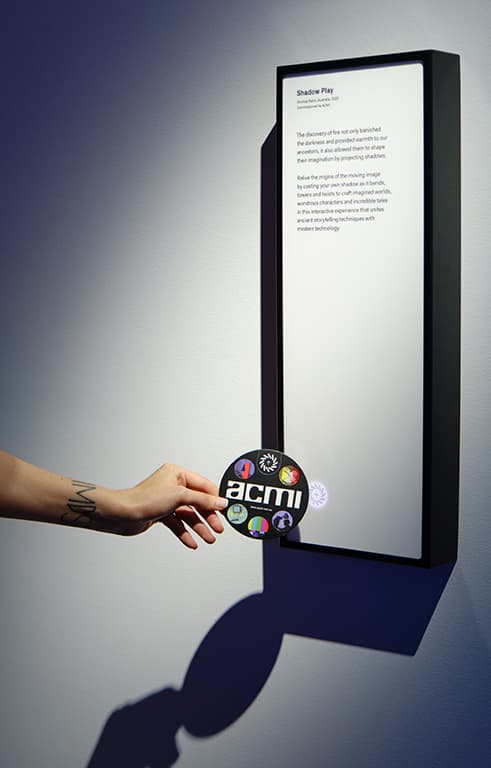
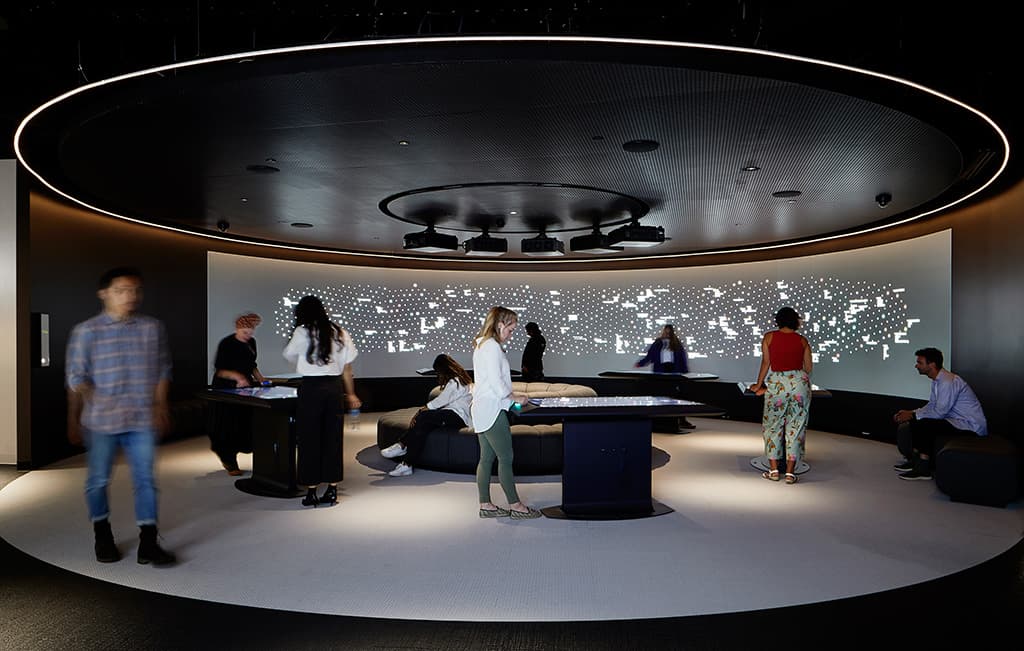
Constellation comprises six interactive touchscreen tables with an interface developed by Grumpy Sailor and a data visualisation called Entities, designed by OOM Creative and More Studio. The Constellation takes the items collected by visitors on their Lens throughout the exhibition and connects them up to hundreds of other films, TV series, artworks and videogames beyond the scope of the gallery. The visualisation is a piece comprising five Panasonic laser projectors edge blended onto a curved screen. The content is highly detailed on a black backdrop. It was a finicky installation, where edge blending black is notoriously difficult.
Evan Davies: “Video content is a lot more forgiving than super detailed data animations. The black banding of the edge blending was very noticeable initially — it looked terrible. A feature on the Panasonic projectors saved our bacon. It allows you to turn the black levels down on the un-blended areas. I’d never heard of people doing this or knew of the feature, but it evened everything out, and essentially saved the display.”
HOMEGROWN: MORE ON NODEL CONTROL
A few years ago Lumicom, a Melbourne-based integrator, was approached by Museum Victoria to create a control system to replace its legacy system, which was no longer supportable. Lumicom assisted in the writing of an IP-based specification that perfectly suited the museum — that addressed network control and was device agnostic — then ultimately wrote the control system specifically for the organisation. This is the origin story of Nodel.
Nodel has come a long way since its launch at Melbourne Museum in 2013 and several museums nationally and internationally have adopted it. There is a small but active group of developers that producing recipes to solve all kinds of sticky integration problems.
The appeal of Nodel is primarily in the way the museum (or any museum with an AV department) can work with it, update it and customise it in-house without recourse to a third-party programmer or integrator.
Scott Summers, in Lumicom’s Engineering Services explains some more: “Ultimately, any museum that uses Nodel, ends up with a Nodel expert internally. It means they can write their own recipes. They don’t really need to come to us, unless they’re time poor or they have a tricky specific request. That was certainly Museum Victoria’s initial intent. They wanted to be a leader in this technology and their longer term plans and goals were to create this software that they could then licence for free to smaller museums that don’t have big budgets, to give them an opportunity, as well to to better manage their own the infrastructure and provide more reliable solutions.”
The beauty of Nodel is it’s eminently scalable. Because it runs on Java, Nodel will work on any device that can run standard Java runtime libraries — anything from a Raspberry Pi to a Windows 10 machine.
A Nodel ‘node’ can be any network device that can be powered up and down — a projector, a PDU, media player etc — and that node itself has its own web interface.
The ‘recipes’ that Nodel controls in each node are written in Python.
Scott Summers: “Because it’s written in Python it’s a human readable script, which is a benefit, and it can all be edited and modified in real time — there’s nothing to compile because everything is in script.”
For the museum, it means they can pull down a particular exhibit, or a particular node, to work on it on the fly while the rest of the museum or gallery is operational.
Nodel can be edited in a web browser and text editor — no special tools are required.
All up, it’s a flexible, lightweight control system.
As for Lumicom, it continues to be the originators and especially adept at working in and with Nodel. They’re also developing some hardware that is super Nodel friendly, including touchscreens and button boxes for boardroom and other commercial application. As you can imagine, Lumicom favours Nodel for all its integration work now, and not just museums.
KEY PERSONNEL
Glenn Willey – Exhibitions Technical Manager
Seb Chan — Chief Experience Officer
Evan Davies – Project Manager (Renewal)
Travis Geldard – AV Technical Manager
KEY SUPPLIERS
Panasonic (projection & displays): panasonic.com.au
Yamaha (audio): au.yamaha.com
iGuzzini (lighting): iguzzini.com



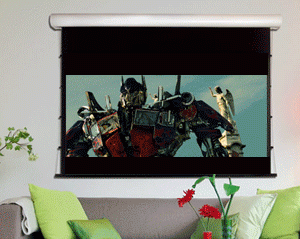


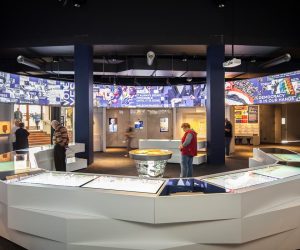

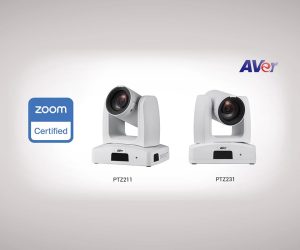
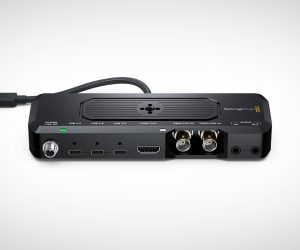




RESPONSES